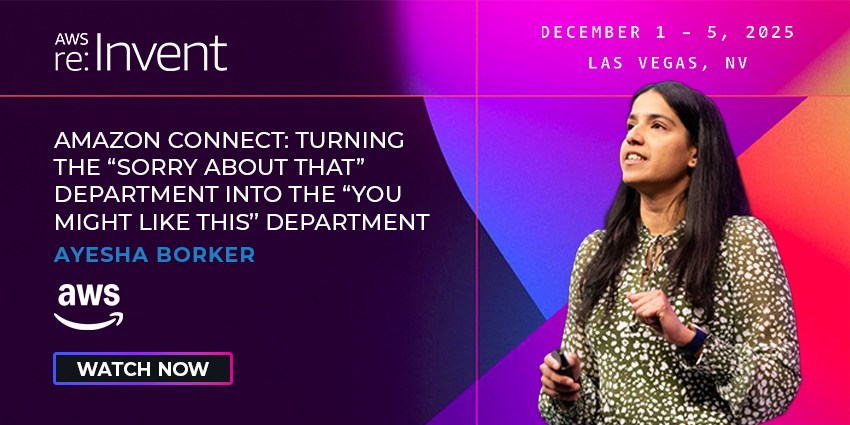Having a vision for the contact center of 2030 gives service leaders something to work towards.
With that vision, they can drive enthusiasm and form a strategy to execute.
The trouble is, with all the latest advancements in technology – alongside the typical day-to-day contact center firefighting – it’s tricky to plan ahead.
As such, here are some predictions that may help contact centers get ahead of the curve.
It Will Leverage AI Agents to Automate Even More Complex Customer Queries
Gartner predicts that AI agents will autonomously resolve four in every five common customer service queries by 2029.
“Common” is an important qualifier here, but even so, contact centers won’t get close to that number with the more dialog-tree-based self-service bots largely in use today.
However, agentic AI leverages knowledge and data sources to complete tasks autonomously. That introduces a new paradigm for customer contact automation.
Not only that, but AI (or virtual) agents can also reason and work with other AI agents across integrated systems to automate multi-step flows.
As such, contact centers will soon be able to automate more complex customer queries as they orchestrate AI agents to resolve various common customer contacts.
Noting this likely shift, Buster Hansen, Director of Solutions Engineering at Enghouse Interactive, stated:
“Right now, organizations are tackling the low-hanging fruit, but in five years, AI-driven self-service will become significantly more profitable and impactful.”
Indeed, Gartner also predicted that AI agents will enable a 30 percent reduction in operational costs over the next four years.
Nevertheless, Hansen stresses the need for a safe approach to future agentic AI by first uncovering common customer contact reasons and then targeting high-volume, low-complexity queries.
From there, the contact center can optimize the knowledge and data sources the AI agent can access, test, and deploy with guardrails to only answer targeted queries.
Such a modular strategy will build confidence and allow the contact center to scale.
It Will Utilize Workforce Engagement Management (WEM) Data In New Ways
Contact centers are evolving their data strategies to deliver a “single pane of glass” customer view and power AI innovations.
However, alongside customer data, service operations also hold a wealth of employee data that often fails to deliver its potential.
Now, with more contact centers investing in cloud-based quality assurance (QA) and workforce management (WFM) systems, that data pile is swelling.
Thankfully, “AI can turn massive amounts of employee data into actionable insight, making processes smoother and more efficient,” said Hansen.
For example, consider how AI may utilize those insights to power the routing engines of tomorrow’s contact centers.
The engine may leverage WFM data to spot when an agent’s shift is about to end and then route them a query that’s likely to be simple so they can leave on time.
Alternatively, it may harness QA data to isolate the queries an agent excels in answering and then send lots of those contacts their way to drive up customer satisfaction.
Yet, that’s just routing. Consider how AI could dynamically adjust agent shifts based on sentiment or auto-draft a personalized coaching plan.
In five years’ time, these possibilities will become realities, with AI agents working within WEM systems to bring them to life.
It Will Be Pre-Emptive, Not Just Proactive
Alongside reactive customer service, AI agents can monitor signals from products, networks, and smart devices to spot problems in real time. They may then proactively – and autonomously – resolve customer issues.
“For example, a grocery store could have sensors on refrigeration units that detect malfunctions,” noted Hansen. “Instead of waiting for someone to notice the issue, an AI virtual agent could trigger an outbound notification—via call, email, SMS, or web chat—alerting staff to check the problem and guiding them on possible solutions.
“The IVA could also, where necessary, offer the option to transfer them to a live agent.”
“The same applies to network outages, where automated messages could inform customers before they even reach out.”
While these are significant opportunities to improve experiences, there’s a step beyond proactive customer service: pre-emptive customer service.
Pre-emptive customer service spots issues before they happen and triggers a preventative action to avoid hampering the experience.
Here’s a good example, again involving an AI agent. Consider a previous contact center conversation where the customer says: “I start work at midday” or “I pick up the kids from 3-4pm.”
Isolating this insight, the AI agent could put a block on the system so the customer never receives outbound comms at those times – unless they’re urgent.
This example highlights how contact centers will soon be able to listen to the customer’s voice, understand what means most to them, and harness that insight to spark pre-emptive action.
It Will Have a Strategy for Machine Customers
“Imagine a customer instructing their AI assistant to resolve an issue with a contact center, essentially machines negotiating with machines,” said Hansen. That’s not too far away.
Indeed, Google recently made two significant moves to usher in this future.
First, it released an experimental “Ask for Me” feature for its search engine. With this, users utilize AI to call businesses on their behalf.
So far, it only supports select queries to mechanics and nail salons. Yet, as evident in the demo below, the feature signals a significant advancement from the old Google Duplex.
We’re testing right now with auto shops and nail salons, to see how AI can help you connect with businesses and get things done. pic.twitter.com/inf5hhj1BS
— Rose Yao (@dozenrose) January 30, 2025
Second, Google filed a patent for an on-device AI agent that answers select calls for users. That could change the nature of outbound and – again – beckon machine-to-machine service.
As a result, customers will increasingly turn to AI to represent them in service conversations.
Indeed, Gartner predicts that 70 percent of customer service journeys will start and end with conversational, third-party assistants on mobile devices by 2028.
Given these innovations and predictions, the contact center of 2030 will be prepared for machine customers. That starts by utilizing machine customers and testing the current contact center experience through the lens of AI.
From there, service teams can spot breaks and accessibility challenges to address and ensure a seamless experience for customer AIs.
It Will Be In the Cloud, Probably
By 2030, SaaS will have become the dominant model for contact centers.
The speed of AI innovation – especially as agentic AI takes hold – will play a significant role here, alongside other benefits, like greater agility, ease of integration, and scalability.
However, as Hansen observes: “Organizations are becoming more comfortable with cloud providers that invest heavily in securing data, often surpassing the security of on-premises solutions.
“AI will also play a role in protecting sensitive information—helping to redact private data before storage, which should ease concerns about transferring information online.”
Nevertheless, some will have stayed put on-prem.
Why? Drumming up resources to make that massive transition, possible new data regulations, and difficult-to-migrate workloads are some potential stumbling blocks.
There’s also the fact that AWS, Google, and Microsoft are all US-based public clouds, meaning the US government has the right to seize that data at any time.
That’s an issue in some regions, even in those where it may not have been a few months ago.
As Finbarr Begley, Senior Research Analyst at Cavell Group, recently told CX Today: “I hear lots of on-prem deals are still happening in Europe.”
“There have been a lot of questions in the last few weeks coming out of Denmark about how they’re building local on-prem data centers to tackle uncertainty,” he continued.
“They’re worried about tariffs and how they can lock in a large contact center in Europe, one that’s already paid for, already purchased, untouchable, and safe.”
As US politics becomes increasingly turbulent, this is a trend to watch, especially for organizations in particular industries, like the public sector.
These brands may wish to work with a provider offering a more flexible contact center model.
Build Towards This Future with Enghouse Interactive
Enghouse Interactive is a stalwart of the contact center technology market, with deep industry expertise and a broad contact center portfolio.
With this portfolio, it focuses on real-world applications of new technologies, enabling the practical applications of game-changing AI.
“We don’t just push AI as a flashy tool,” summarized Hansen. “We focus on solving real problems and deploying technology in ways that make a tangible impact. We also ensure we are offering a secure, transparent tool-set that our partners and customers can feel very confident with.”
To learn more about Enghouse Interactive, visit their website.







